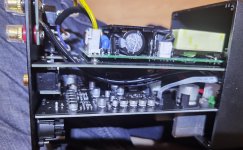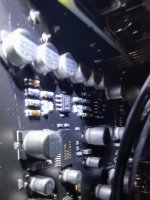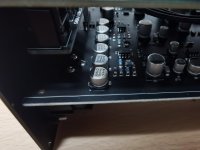Have tested with the bookshelf two way... Same results
Active active systems present the easiest possible loads and drive requirements for any amplifier.
All passive crossovers "suck" energy and present additional resistance/load demands to the amplifier. The easiest drive load possible is just hook the driver up directly to an amplifier. Fact.
Also, for your information, its not the size, its the sensitivity (often mistaken for efficiency which not the same) of loudspeakers that makes for an easy or difficult load/ high SPL/dynamics.
If you look at the photos of my system you will see that the "core" is a bookshelf two way, both the 10 inch bass mid (35Hz to 400Hz) and the mid/top (covering 400Hz to 15KHz) RED driver are 90dB/1 watt @1 meter... Way more sensitive than a typical passive crossover /bookshelf loudspeaker.
Also for your information the Ref modified Belles in stereo mode does 125 watts per channel into 8 Ohms, 200 watts into 4 Ohms and holds a stable 400 watts into 2 Ohms. In Mono this increases significantly.
The great amplifier designers will admit, off the record in most cases, that that approx 80% of the sound quality (not the typical sales brochure noise/THD/IMD specs) ANY amplifier is dependant on the quality of the power supply.
Compared to the Belles, or any similar well designed class A/B high current/power amplifier, the Sabaj (or ANY amplifier with a light weight low capacity power supply) can never generate the high current transient control to match the sound, dynamics and maintain decent time domain accuracy when asked to reproduce bass/low midrange at high SPL.
Even driving the 100dB sensitive Beyma TPL tweeter you can hear the difference and the power requirements here are low. Its gets more noticeable in the midrange and is a non starter in the bass/low mid.
So, in conclusion the Sabaj is a great value amp.
The Sbaj is suited for easy loads and low / medium SPL.
The Sabaj is superb in active systems driving undemanding high efficiency drivers.
The Sabaj, can not break the laws of physics and can not compete with true high power/current class AB amps.
The Sabaj is not suited for bass/low midrange at high SPL even in active systems.
Active active systems present the easiest possible loads and drive requirements for any amplifier.
All passive crossovers "suck" energy and present additional resistance/load demands to the amplifier. The easiest drive load possible is just hook the driver up directly to an amplifier. Fact.
Also, for your information, its not the size, its the sensitivity (often mistaken for efficiency which not the same) of loudspeakers that makes for an easy or difficult load/ high SPL/dynamics.
If you look at the photos of my system you will see that the "core" is a bookshelf two way, both the 10 inch bass mid (35Hz to 400Hz) and the mid/top (covering 400Hz to 15KHz) RED driver are 90dB/1 watt @1 meter... Way more sensitive than a typical passive crossover /bookshelf loudspeaker.
Also for your information the Ref modified Belles in stereo mode does 125 watts per channel into 8 Ohms, 200 watts into 4 Ohms and holds a stable 400 watts into 2 Ohms. In Mono this increases significantly.
The great amplifier designers will admit, off the record in most cases, that that approx 80% of the sound quality (not the typical sales brochure noise/THD/IMD specs) ANY amplifier is dependant on the quality of the power supply.
Compared to the Belles, or any similar well designed class A/B high current/power amplifier, the Sabaj (or ANY amplifier with a light weight low capacity power supply) can never generate the high current transient control to match the sound, dynamics and maintain decent time domain accuracy when asked to reproduce bass/low midrange at high SPL.
Even driving the 100dB sensitive Beyma TPL tweeter you can hear the difference and the power requirements here are low. Its gets more noticeable in the midrange and is a non starter in the bass/low mid.
So, in conclusion the Sabaj is a great value amp.
The Sbaj is suited for easy loads and low / medium SPL.
The Sabaj is superb in active systems driving undemanding high efficiency drivers.
The Sabaj, can not break the laws of physics and can not compete with true high power/current class AB amps.
The Sabaj is not suited for bass/low midrange at high SPL even in active systems.
Last edited:
With a 350W PSU and the average consumer buying a 200$ amplifier playing way below 2 x 5W on relatively high efficiency/sensitive 2 way bookshelf speakers things are relative.
For the intended PA use one should look elsewhere indeed 🙂
For the intended PA use one should look elsewhere indeed 🙂
Last edited:
The Sbaj is suited for easy loads and low / medium SPL.
The Sabaj is superb in active systems driving undemanding high efficiency drivers.
The Sabaj, can not break the laws of physics and can not compete with true high power/current class AB amps.
The Sabaj is not suited for bass/low midrange at high SPL even in active systems.
Sounds perfectly clear ) nice feedback thanks a lot )
You are welcome and if anyone in the Cambridge area wants to hear the superb sound they produce driving the Beyma TPL tweeters I am happy to give a quick demo... I cant think of any amp under about £800 that can match their overall package - Balanced inputs, great build quality and superb sound, plus a volume control!
I agree that the strength of this amp is the mid-range and high frequency. That said, it is not bad in the lower regions, but I did notice that my other class D has much more power into 8 ohm and maybe 80db sensitivity. I have some other speakers with very linear impedance and higher SPL, they should be a perfect match.
Compared to my EL34 Push pull amp, which is really good, the Sabaj has more control, more finesse and is just more musical. It beats the tube amp in its own backyard, which is a big surprise to me.
Especially after looking inside and finding smd electrolytics right in the signal path, ceramic resistors galore and so on. All that stuff which is supposed to sound really bad... No Audio Note resistors anywhere 😉
As a side note: I've set the voltage to the maximum of the power supply to 25.85 volt, which to my ears was clearly audible. Just a bit more snappier and a little bit more control in the lower areas.
I am praying for a Merus Chip, which runs with 48 Volt😱
Compared to my EL34 Push pull amp, which is really good, the Sabaj has more control, more finesse and is just more musical. It beats the tube amp in its own backyard, which is a big surprise to me.
Especially after looking inside and finding smd electrolytics right in the signal path, ceramic resistors galore and so on. All that stuff which is supposed to sound really bad... No Audio Note resistors anywhere 😉
As a side note: I've set the voltage to the maximum of the power supply to 25.85 volt, which to my ears was clearly audible. Just a bit more snappier and a little bit more control in the lower areas.
I am praying for a Merus Chip, which runs with 48 Volt😱
Some time ago I tricked an audio friend by bringing a DIY amplifier not mentioning what was in the casing. We compared with an Audio Note tube device of sorts. The DIY amplifier was way better with bass and comparable with the mids but it lost with the highs. It was judged as being very good. Of course the device was stereotyped as semiconductor stuff because of the small casing. Next time I will use a square meter casing with a few amber LEDs glowing inside.
Then I told the device existed of 2 x Sanwu TPA3118 6 Euro costing mono amplifiers fed by a 12V linear PSU by my own design (R-core transformer with LT1764A).
I apologized for the ceramic input caps 🙂 The guy ordered some of these modules.
Then I told the device existed of 2 x Sanwu TPA3118 6 Euro costing mono amplifiers fed by a 12V linear PSU by my own design (R-core transformer with LT1764A).
I apologized for the ceramic input caps 🙂 The guy ordered some of these modules.
Last edited:
Active active systems present the easiest possible loads and drive requirements for any amplifier.
All passive crossovers "suck" energy and present additional resistance/load demands to the amplifier. The easiest drive load possible is just hook the driver up directly to an amplifier. Fact.
In over 30 years of messing with audiophile components and DIY stuff I never heard an active system sounding better than a passive crossover!
For me a passive crossover with very good parts will win every shootout easily. Passive crossover sounds better than DSP and better than active. It sounds just more like flesh and blood and most importantly passive sounds better in the rhythm department for sure. The amp to speaker connection is a very complex situation with many variables.
Especially after looking inside and finding smd electrolytics right in the signal path, ceramic resistors galore and so on. All that stuff which is supposed to sound really bad... No Audio Note resistors anywhere
As a side note: I've set the voltage to the maximum of the power supply to 25.85 volt, which to my ears was clearly audible. Just a bit more snappier and a little bit more control in the lower areas.
I am praying for a Merus Chip, which runs with 48 Volt
Could you please share some pictures of the internal unit ?
I unfortunately did not have time to disassemble it and I would be curious to see the OP amps inside )
If you like the MA12070 check this one that can be bridged; the max PVDD = 26V
Amplificateur numerique hi fi de haute qualite, Module MERUS MA12070 2x80w | AliExpress
I made a dual Mono MA12070 with balanced inputs and 2 SMPS PSUs.(see previous post)
Last edited:
I made some pictures, opamps are op1678. On one pic there is a row of 6 lyrics on the left, these are the input caps for balanced and single ended. Good quality board and components, they even use melf resistors.
Attachments
Unfortunately the little adjustment potentiometer is located at the end of the power supply, so you have to pull out the boards completely out of the case in order to change the voltage. There are two ribbon cables which have to be unplugged at the boards, but it is a PITA to get them back in.
Would be interesting if they sound better...there are 4 more caps before the chips as far as I can see.
Many thanks for the pictures )
I'm pretty sure we'll see a thread soon called "Sabaj A20A mod")))))))
I'm pretty sure we'll see a thread soon called "Sabaj A20A mod")))))))
You could fulfill those prayers tomorrow by using two SabajA20a as monoblocks. Or couldn't you? Sadly my speakers do not support bi-wiring, but I played with the idea in my head for some time. The amp is very good, I mean it's superbly detailed on my speakers and textured without getting harsh or sibilant. It just lacks a bit of power to really kick some *****. I'd love to have at least one proper testing of it though. And I love that the display is so simple (hopefully will last longer than a fancy highres display), but I'd really like to have it plain, good ol' white.I am praying for a Merus Chip, which runs with 48 Volt😱
Last edited:
I was thinking that the first mod to perform could possibly change the PSU which is a Morsun @ 350W with PFC support
The Meanwell RPS-400-24 PSU should fit and seems to have almost the same size / frame :
- It has a better Ripple&Noise
- They can reach 250/470W short term before going into hiccup mode (200/385W@Mornsun LOF350).
- The Morsun is certified CISPR 32 vs CISPR 11 for the Meanwell = better against EMI
So you can compare :
RPS-400-MEAN WELL Switching Power Supply Manufacturer
LOF350-20B24_Mornsun Power Supply Manufacturer/Company/Supplier/Factory

The Meanwell RPS-400-24 PSU should fit and seems to have almost the same size / frame :
- It has a better Ripple&Noise
- They can reach 250/470W short term before going into hiccup mode (200/385W@Mornsun LOF350).
- The Morsun is certified CISPR 32 vs CISPR 11 for the Meanwell = better against EMI
So you can compare :
RPS-400-MEAN WELL Switching Power Supply Manufacturer
LOF350-20B24_Mornsun Power Supply Manufacturer/Company/Supplier/Factory

Last edited:
- Home
- Vendor's Bazaar
- DUAL Merus MA12070 fully balanced Amplifier pictures inside


